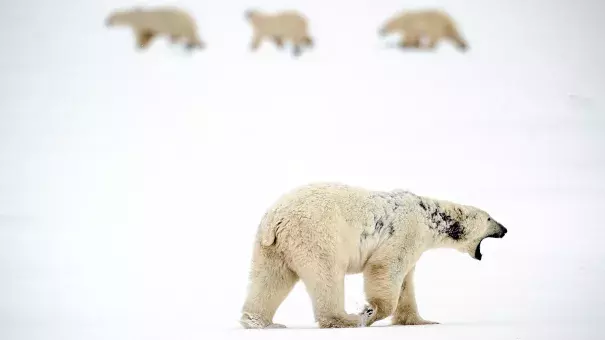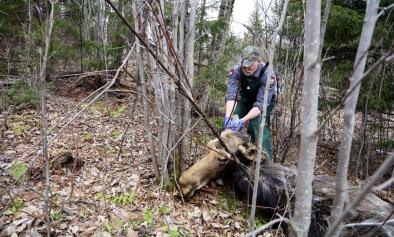Is Warming Bringing a Wave of New Diseases to Arctic Wildlife?

During the last week of September, Inuit residents in the community of Arviat on the northwest coast of Hudson Bay were surprised to see a mysterious whale following a small boat heading back to the village. The whale was at least twice the size of the 15- to 20-foot-long beluga whales that are traditionally seen in this part of the world.
Based on the photos taken, scientists concluded that the whale was a humpback, the first ever seen in that part of Hudson Bay, and one of a handful that have recently been spotted in the North American Arctic.
Humpbacks are not the only marine mammals that have been expanding their range northward. Most notably, as sea ice melts, ice-avoiding killer whales have been moving deeper into the Arctic Ocean, hunting and killing both narwhal and beluga whales. Other whale species — including minke, bottlenose, fin, and sperm whales — are also making their way north as the Arctic heats up. At the same time, on land, grizzly bears, white-tailed deer, coyotes, and other animals and birds have been expanding their range into the warming boreal forest and Arctic tundra.
For the indigenous people who subsist on Arctic animals such as muskoxen, caribou, seals, polar bears, and eider ducks — species that are in decline in some places — the newcomers are potentially a welcome addition to their diet. But emerging evidence suggests that some of these newly arriving species may be bringing rare or novel pathogens to the Arctic. In recent years, a plethora of deadly and debilitating diseases have struck reindeer in Scandinavia and Russia, muskoxen on Banks and Victoria islands in Arctic Canada, polar bears and seals off the coast of Alaska, and eider ducks in northern Hudson Bay and the Bering Sea.
Susan Kutz — a University of Calgary veterinary parasitologist who identified a novel form of the parasitic nematode worm, the lungworm, in muskoxen in the High Arctic — is one of a small number of veterinarians and biologists trying to decipher the causes and impacts of changing disease outbreaks in the Arctic. One possibility, she and other scientists say, is that climate warming and ecosystem changes are causing some bacteria, such as those that cause avian cholera, to mutate, or may be making Arctic animals more susceptible to pathogens that previously did them no serious harm.
Another possibility being investigated by scientists is that bacteria such as anthrax — an outbreak of which resulted in the culling of 250,000 reindeer in western Siberia in 2016 and 2017 — are being liberated by rapidly thawing permafrost. The anthrax outbreak in the far northern Yamal-Nenets Autonomous Okrug of Siberia compelled Russia’s Department of Defense to launch an emergency task force to help vaccinate 730,000 reindeer. One person died from anthrax, and several dozen reindeer herders got sick when the animals succumbed to the disease. A record heat wave that swept across the tundra that summer is thought to have thawed out reindeer carcasses that were infected with the spores.
Related Content



